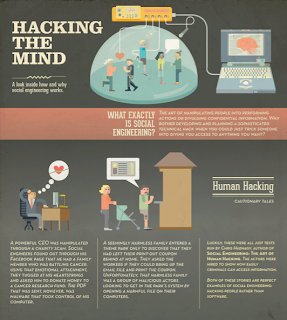 |
| Source: Cybercrime Review (detail) |
We’ve heard of phishing, hacking, or just looking over someone’s shoulder, but this approach is much more, as illustrated in the infographic Hacking the Mind from Veracode. Social engineering affects everyone. Perhaps a good way to describe it is human hacking.
Security Search describes it as away to trick people into breaking normal security procedures by gaining the confidence of the user. Our learners are particular vulnerable to this, because social engineering is designed to exploit the natural trust children have of others, to take advantage of their naïveté, or to prey on their weaknesses from not being fully informed.
While we constantly talk to our students to remind them how to protect themselves online, we have never used the term social engineering. For that reason, we began showing them the following Social Engineering motion graphic to help them build an understanding of what it is and to become familiar with the term.
As we’ve mentioned many times before, we find that visualizations help to seal the deal and make the message better understood. Our young learners have a lot to think about in the digital world. Anytime we can give them one more view of how to protect themselves from online scams, the better.












